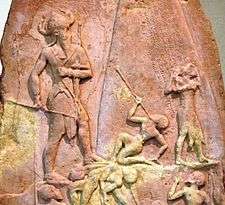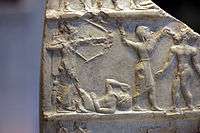Naram-Sin of Akkad
| Naram-Sin or Naram-suen | |
|---|---|
| King of Akkad | |
 Victory Stele of Naram-Sin, c. 2230 BC. It shows him defeating the Lullibi, a tribe in the Zagros Mountains, trampling them and spearing them. He is also twice the size of his soldiers. In the 12th century BC it was taken to Susa, where it was found in 1898. | |
| Reign | c. 2254 BC – 2218 BC |
| Predecessor | Manishtushu |
| Successor | Shar-Kali-Sharri |
| Dynasty | Dynasty of Akkad |
| Father | Manishtushu |
Naram-Sin (also transcribed Narām-Sîn or Naram-Suen, meaning "Beloved of Sin"; reigned ca. 2254–2218 BCE,[1]) was a ruler of the Akkadian Empire, the third successor and grandson of King Sargon of Akkad. Under Naram-Sin the empire reached its maximum strength. He was the first Mesopotamian king known to have claimed divinity for himself, taking the title "God of Akkad", and one of the first (following the earlier Lugal-Anne-Mundu) claim the title "King of the Four Quarters, King of the Universe".
Biography
Naram-Sin was born as a son of Manishtushu. He was thus a nephew of King Rimush and grandson of Sargon and Tashlultum. Naram-Sin's aunt was the High Priestess En-hedu-ana.
Reign

Naram-Sin traded with Meluhha (almost certainly corresponding to the Indus Valley civilization), and controlled a large portion of land along the Persian Gulf. He defeated Manium (who may have been king Menes of Egypt) of Magan, and various northern hill tribes in the Zagros, Taurus, and Amanus Mountains, expanding his empire up to the Mediterranean Sea and Armenia. His "Victory Stele" depicts his triumph over Satuni, chief of Lullubi in the Zagros Mountains. The king list gives the length of his reign as 56 years, and at least 20 of his year-names are known, referring to military actions against various places such as Uruk and Subartu. One unknown year was recorded as "the Year when Naram-Sin was victorious against Simurrum in Kirasheniwe, and took prisoner Baba the governor of Simurrum, and Dubul the ensi of Arame".[2] Other year names refer to his construction work on temples in Akkad, Nippur, and Zabala. He also built administrative centers at Nagar and Nineveh.
The Curse of Akkad
One Mesopotamian myth, a historiographic poem entitled "The curse of Akkad: the Ekur avenged", explains how the empire created by Sargon of Akkad fell and the city of Akkad was destroyed. The myth was written hundreds of years after Naram-Sin's life, and is the poet's attempt to explain how the Gutians succeeded in conquering Sumer. After an opening passage describing the glory of Akkad before its destruction, the poem tells of how Naram-Sin angered the chief god Enlil by plundering the Ekur (Enlil's temple in Nippur.) In his rage, Enlil summoned the Gutians down from the hills east of the Tigris, bringing plague, famine and death throughout Mesopotamia. Food prices became vastly inflated, with the poem stating that 1 lamb would buy only half a sila (about 425ml) of grain, half a sila of oil, or half a mina (about 250g) of wool.[3] To prevent this destruction, eight of the gods (namely Inanna, Enki, Sin, Ninurta, Utu, Ishkur, Nusku, and Nidaba) decreed that the city of Akkad should be destroyed in order to spare the rest of Sumer and cursed it. This is exactly what happens, and the story ends with the poet writing of Akkad's fate, mirroring the words of the gods' curse earlier on:
"Its canalboat towpaths grew nothing but weeds,
Its chariot roads grew nothing but the 'wailing plant,'
Moreover, on its canalboat towpaths and landings,
No human being walks because of the wild goats, vermin, snakes, and mountain scorpions,
The plains where grew the heart-soothing plants, grew nothing but the 'reed of tears,'
Akkad, instead of its sweet-flowing water, there flowed bitter water,
Who said "I would dwell in that city" found not a good dwelling place,
Who said "I would lie down in Akkad" found not a good sleeping place."
Gutian Incursions
 | |
|
|
These Gutian raids were indeed devastating, but it is unknown how badly they affected Sumer. Naram-Sin may have passed on his empire to his son Shar-Kali-Sharri more or less intact upon his death in c. 2219 BC, or he may have passed on little more than Akkad itself.[4] However it is clear that soon after the death of Naram-Sin, the Akkadian Empire came under increasing pressure from the more and more frequent Gutian incursions, to the point that by c. 2100 BC, it seems that all of Akkad except the city itself was in the hands of the Gutians. The Gutians remained there for over 100 years before being replaced by the Ur III state as the dominant political power.[5][6]
Victory stele

Naram-Sin's Victory Stele depicts him as a god-king (symbolized by his horned helmet) climbing a mountain above his soldiers, and his enemies, the defeated Lullubi. Although the stele was broken off at the top when it was stolen and carried off by the Elamite forces of Shutruk-Nakhunte, it still strikingly reveals the pride, glory, and divinity of Naram-Sin. The stele seems to break from tradition by using successive diagonal tiers to communicate the story to viewers, however the more traditional horizontal frames are visible on smaller broken pieces. It is six feet and seven inches tall, and made from pink limestone.[7] The stele was found at Susa, and is now in the Louvre Museum.[8] A similar bas-relief depicting Naram-Sin was found a few miles north-east of Diarbekr, at Pir Hüseyin.
Children
The only known son of Naram-Sin was his successor Shar-Kali-Sharri. Excavations at Tell Mozan (ancient Urkesh) brought to light a sealing of Tar'am-Agade, a previously unknown daughter of Naram-Sin, who was possibly married to an unidentified endan (ruler) of Urkesh.[9]
See also
References
- ↑ middle chronology
- ↑ Year-Names of Naram-Sin of Agade
- ↑ Samuel Noah Kramer (2010-09-17). The Sumerians: Their History, Culture, and Character. University of Chicago Press. ISBN 0 226 45238 7.
- ↑ Samuel Noah Kramer (2010-09-17). The Sumerians: Their History, Culture, and Character. University of Chicago Press. ISBN 0 226 45238 7.
- ↑ Babylonian Life and History, by E. A. Wallis Budge
- ↑ Julian Reade (2000). Mesopotamia. British Museum Press. pp. 67–68. ISBN 0-7141-2181-9. OCLC 43501084.
- ↑ Kleiner, Fred (2005). Gardner's Art Through The Ages. Thomson-Wadsworth. p. 41. ISBN 0-534-64095-8.
- ↑ Louvre ( Arts and Architecture). Köln: Könemann. ISBN 3-8331-1943-8.
- ↑ Buccellati, Giorgio; Kelly-Buccellati, Marilyn (2002). "Tar'am-Agade, Daughter of Naram-Sin, at Urkesh" (PDF). In Al-Gailani Werr, Lamia. Of Pots and Plans. Papers on the Archaeology and History of Mesopotamia and Syria presented to David Oates in Honour of his 75th Birthday. London: Nabu. pp. 11–31. ISBN 1897750625. Retrieved 18 March 2015.
Sources
- H.W.F. Saggs, The Babylonians, Fourth Printing, 1988, Macmillan Publishers Ltd.
- J. P. Naab, E. Unger, Die Entdeckung der Stele des Naram-Sin in Pir Hüseyin, Istanbul Asariatika Nesriyati XII (1934).
External links
| Wikimedia Commons has media related to Naram-Suen. |